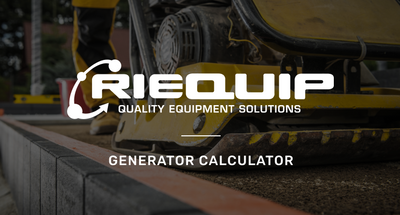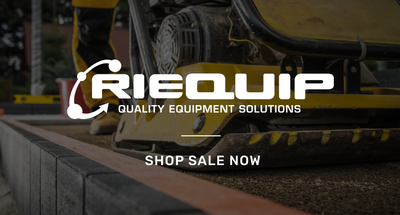How to use a Plate Compactor like a Pro
Plate compactors are vital tools in construction, crucial for compacting soil, asphalt, gravel, and more to create a sturdy foundation. Whether for road work, landscaping, or driveway installation, understanding plate compactor operation is essential for success.
In this guide, we'll cover the plate compactor process, from preparation and safety to operating techniques and maintenance, empowering you to utilise your compactor effectively for successful construction projects.
Understanding Plate Compactors
Plate compactors operate by powering a vibrating base that rapidly moves up and down, penetrating the material and reducing air voids to increase density. Effectiveness depends on factors like machine size, weight, vibration frequency, amplitude, and material type.
Compactness varies based on plate compactor size and weight, with larger models exerting more force, suitable for thicker material layers. Reversible plate compactors offer versatility for tight spaces, while handheld models suit smaller-scale projects or inaccessible areas.
Preparing for Operation
Before you start operating your plate compactor, here are some steps to follow to ensure optimal operation and safety:
1. Inspect the Machine
Check the plate compactor for any signs of damage, such as cracks or worn-out components. Check the engine, fuel tank, hydraulic system, and vibrating plate for any issues that may affect the machine’s performance or safety.
2. Check Fluid Levels
Make sure the machine has adequate supply of fuel, engine oil and hydraulic fluid. Top up the fuel tank and oil reservoirs as needed to ensure uninterrupted operation during compaction. Also check the air filter is clear, replace if necessary.
3. Check Safety Features
Ensure all safety features on the compactor are functional. Test the engine kill switch, throttle control, and emergency stop button before you start operation to verify they engage and disengage smoothly.
4. Clear the Work Area
Remove any debris, rocks, or other obstructions from the work area where the plate compactor will operate. This will prevent damage to your machine and ensure a smooth and efficient compaction.
5. Wear Personal Protective Equipment (PPE)
Before operating the plate compactor, make sure you have the appropriate PPE. This includes safety glasses, hearing protection, gloves, and steel-toed boots. This equipment will minimise the risk of accidents or injury via flying debris, loud operating noises, and crushing injuries.
Proper Operating Techniques
Operating a plate compactor effectively requires proper technique to achieve optimal compaction results while ensuring safety. Here are some key operating techniques to follow when using a plate compactor:
1. Start the Machine
Begin by starting the plate compactor’s engine according to the manufacturer’s instructions. Allow the engine to warm up for a few minutes.
2. Position the Machine
Position the compactor at the edge of the area to be compacted, ensuring that the vibrating plate is parallel to the surface. Make sure there are no obstacles or obstructions in the path of the compactor.
3. Engage the Vibrating Plate
Increasing the revs of engine to full throttle will engage the vibration mechanism to activate the vibrating plate.
4. Move in Overlapping Passes
The plate compactor will automatically move forward in a straight line, ensure to overlap each pass slightly to ensure uniform compaction across the entire surface. Try to be consistent with your movement, avoid sudden stops or changes in direction. This can result in uneven compaction.
5. Apply Even Pressure
As you are compacting, apply even pressure to the handlebars of the plate compactor. Maintain a steady pace throughout the compaction process. Avoid leaning or tilting the machine to one side - this can lead to uneven compaction and damage to equipment.
6. Overlap Edges and Corners
Pay special attention to compacting the edges and corners of the area to be compacted, as these areas are often prone to uneven compaction. Make multiple passes around the edges and corner to ensure thorough compaction.
7. Regularly Check Compaction Quality
Periodically stop the plate compactor and visually inspect the compacted surface for uniformity and density. If any areas look uneven or under-compacted, make additional passes with the compactor to achieve the desired compaction quality.
8. Follow Safety Precautions
Always follow the manufacturer’s safety guidelines and recommendations for your compactor. Wear appropriate PPE to protect yourself during operation. Maintain proper body mechanics while operating the plate compactor - stand in a stable position with your feet shoulder-width apart and your knees slightly bent. Use your legs and core muscles to control the movement of the machine.
Handling Different Surfaces
Different surfaces require different techniques and approaches when it comes to compaction. Here are some tips for effectively compacting different surfaces:
Asphalt
- Ensure the surface is free of debris, oil, or other contaminants before compacting.
- Use a robber pad attachment to prevent damage to the asphalt surface and achieve a smoother compaction.
- Monitor the temperature of the asphalt surface, as compaction is most effective when the asphalt is still hot and pliable.
Gravel
- Spread the gravel material evenly across the surface and ensure that it is properly graded to achieve uniform compaction.
- Use a plate compactor with a high centrifugal force to achieve effective compaction of the gravel particles and minimize voids in the material.
- Make multiple passes over the gravel surface, focusing on compacting the entire depth of the material to create a stable and durable base.
Pavers
- When compacting pavers, ensure that they are installed properly with a uniform gap between each paver to allow for proper compaction.
- Use a plate compactor with a rubber pad attachment to prevent damage to the surface of the pavers and achieve smooth, even compaction.
- Make multiple passes over the surface of the pavers, focusing on compacting the joints between each paver to ensure stability and prevent shifting over time.
- Use caution when compacting pavers to avoid cracking or damaging the surface of the individual pavers.
Troubleshooting Common Issues
When using your plate compactor, you may encounter issues that can affect performance and efficiency. Here are some common issues and how to troubleshoot them:
Engine Starting Problems
- If the engine fails to start, check the fuel level and ensure that the fuel valve is open.
- Verify that the choke is in the correct position for starting, especially in cold weather.
- Check the spark plug for signs of fouling or damage and replace if necessary.
- Ensure that the air filter is clean and free of debris, as a clogged air filter can restrict airflow to the engine.
Engine Stalling or Running Rough
- If the engine stalls or runs rough during operation, check the fuel quality and ensure that it is free of contaminants.
- Inspect the spark plug for signs of fouling, corrosion, or damage and clean or replace it if necessary.
- Check the carburetor for dirt, debris, or clogs that may be affecting fuel flow, and clean or replace as needed.
- Adjust the throttle and choke settings to ensure proper engine operation and fuel-air mixture.
Plate Compactor Vibrations
- Excessive vibrations during operation may indicate worn or damaged engine mounts, which should be inspected and replaced if necessary.
- Check the plate compactor's base plate for damage or wear, as a damaged base plate can cause vibrations and affect compaction quality.
- Ensure that the plate compactor is properly lubricated, as dry or worn bearings can cause excessive vibrations.
Uneven Compaction
- If the plate compactor is not compacting evenly, check the surface being compacted for irregularities or soft spots that may require additional attention.
- Adjust the compaction speed and direction to ensure uniform compaction across the entire surface area.
- Ensure that the plate compactor is properly calibrated and adjusted for the type of material being compacted, as different materials may require different compaction settings.
Loss of Power
- If the plate compactor experiences a loss of power during operation, check the engine oil level and ensure that it is within the recommended range.
- Inspect the fuel lines and fuel filter for clogs or restrictions that may be affecting fuel flow to the engine.
- Check the air filter for clogs or debris that may be restricting airflow to the engine, and clean or replace it as needed.
- If the engine continues to lose power, consult the manufacturer's manual or seek professional assistance to diagnose and address the issue.
Final Thoughts
By understanding the function and operation of the plate compactor, adhering to safety precautions, and implementing proper maintenance practices, you can maximise its utility and ensure the success of your projects.
Remember to always prepare the compactor and the work area thoroughly, follow proper operating techniques, and address any common issues or troubleshooting challenges that may arise during operation. With the right knowledge and approach, you can harness the full potential of your plate compactor and achieve optimal compaction results with ease.
If you’re ready to start compacting, check out our selection of plate compactors at Riequip. All our products are tested before shipping to ensure quality and performance, browse our selection now!


